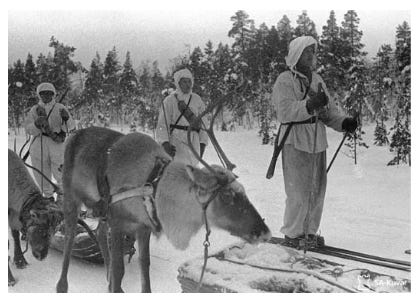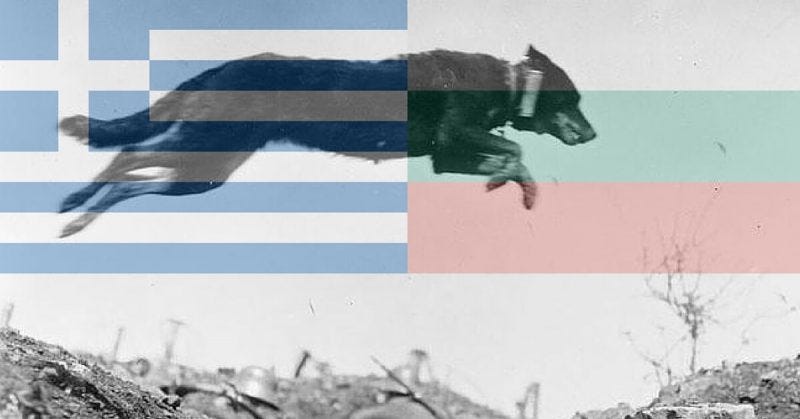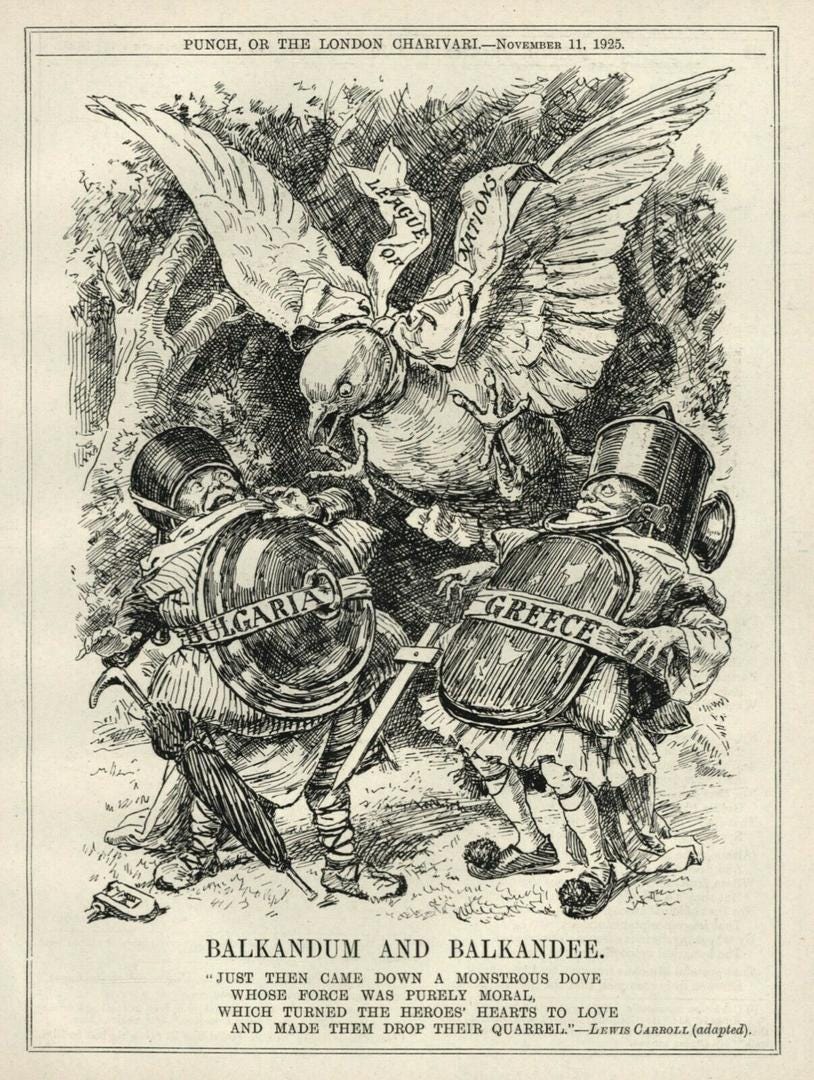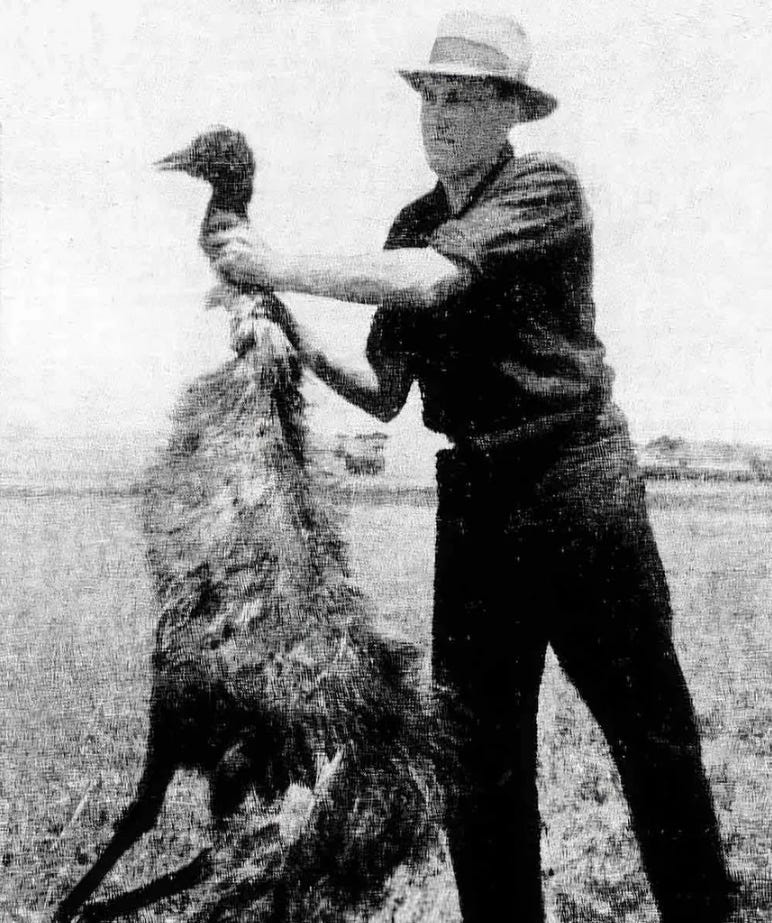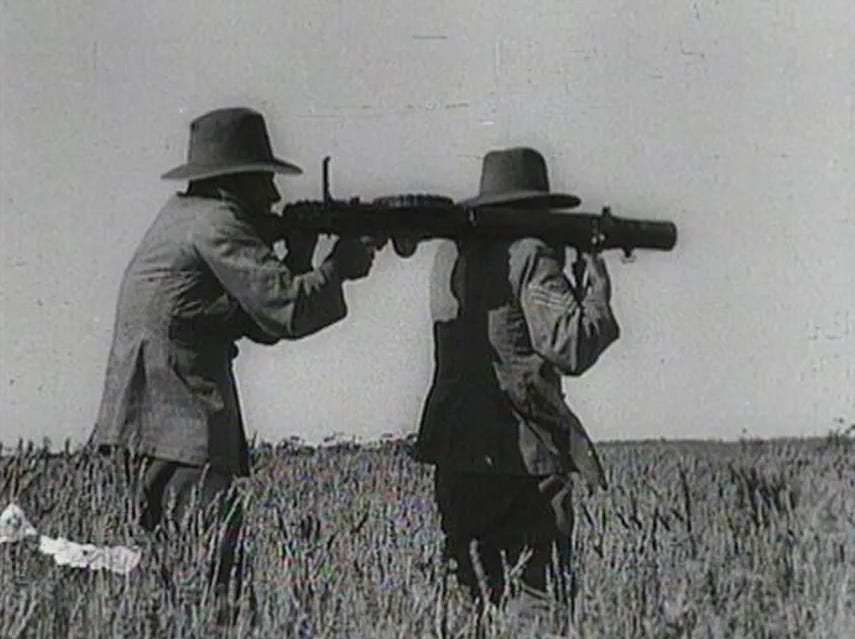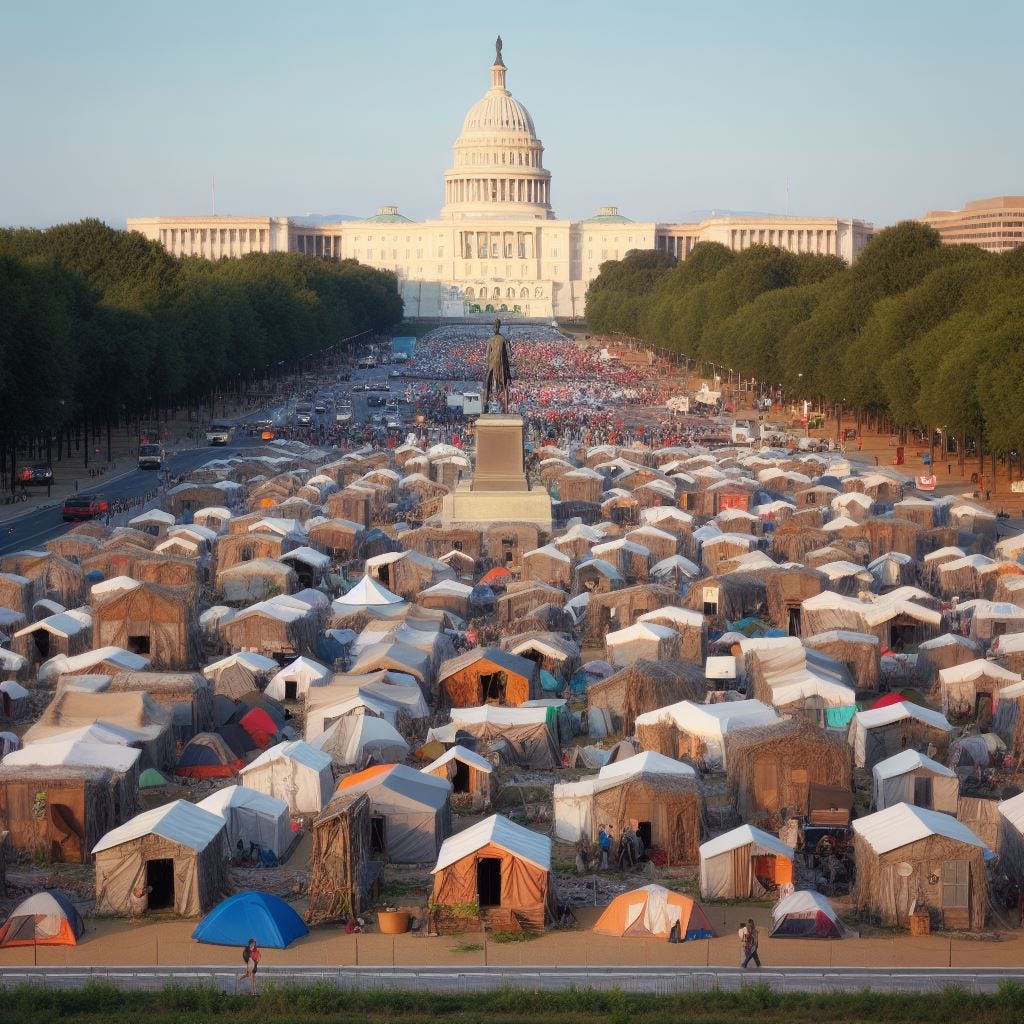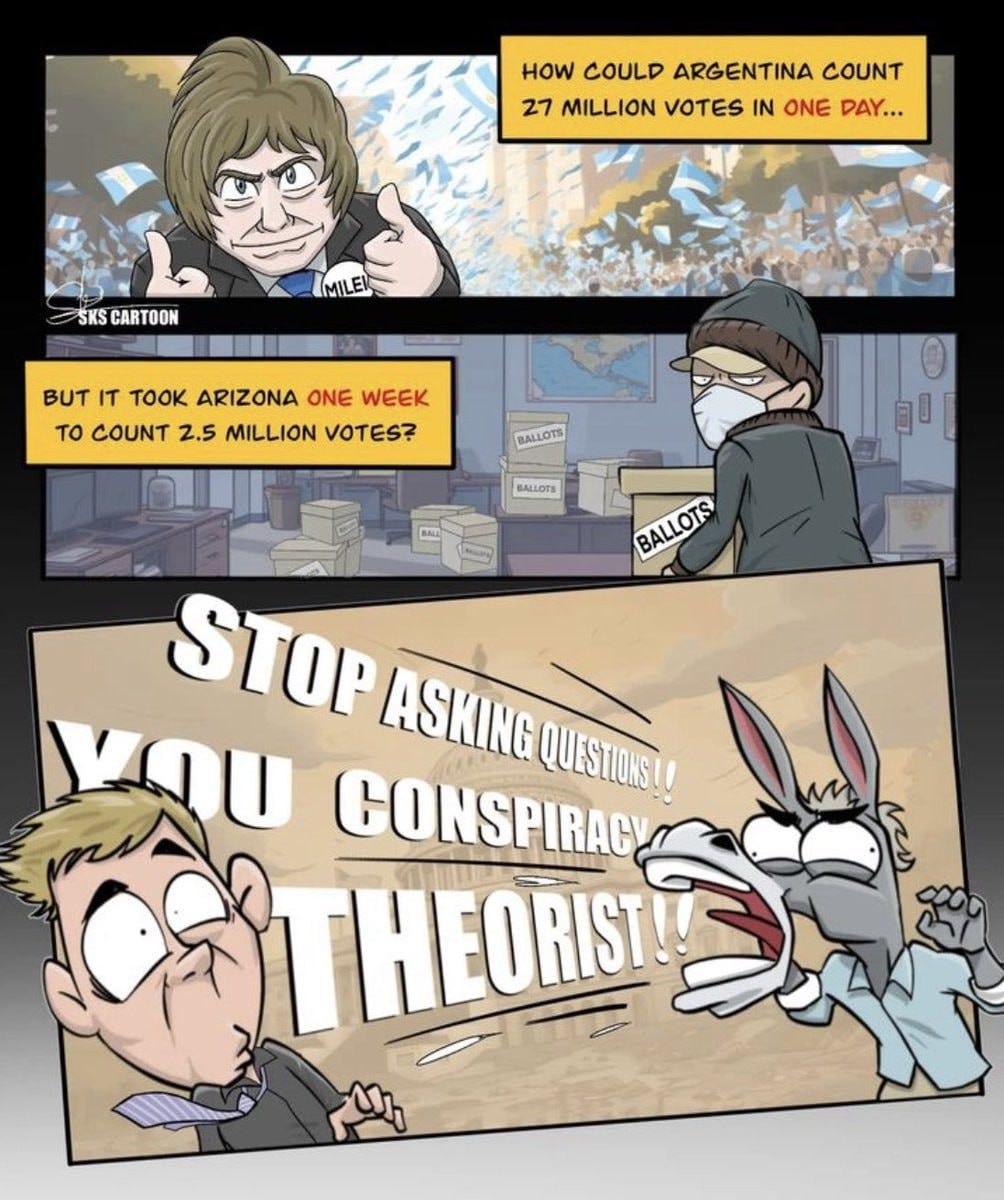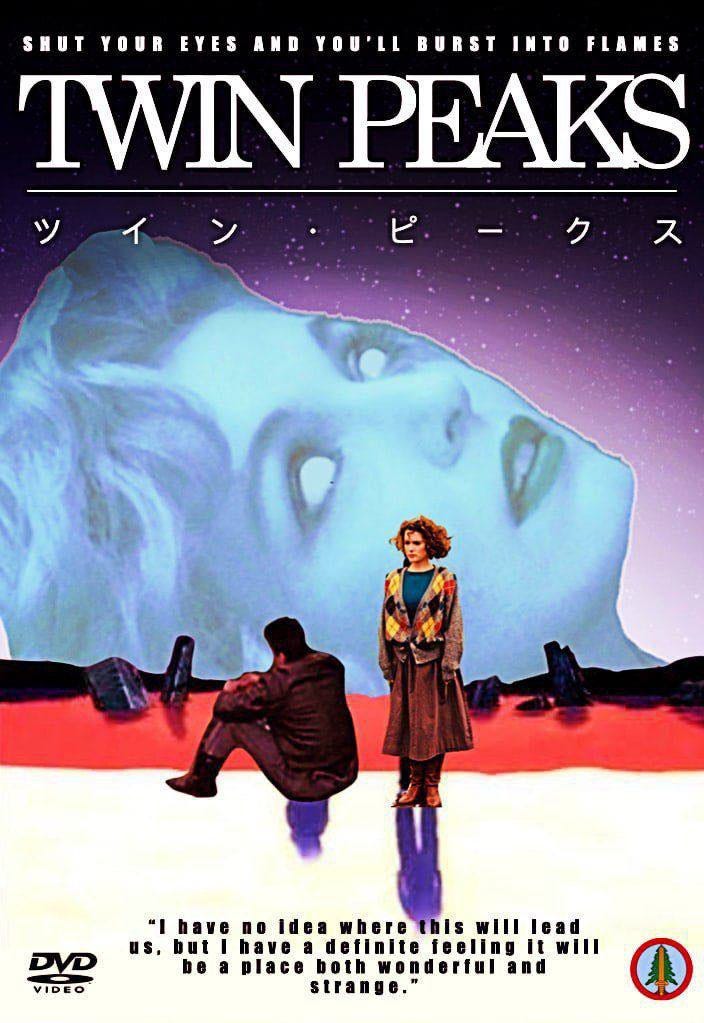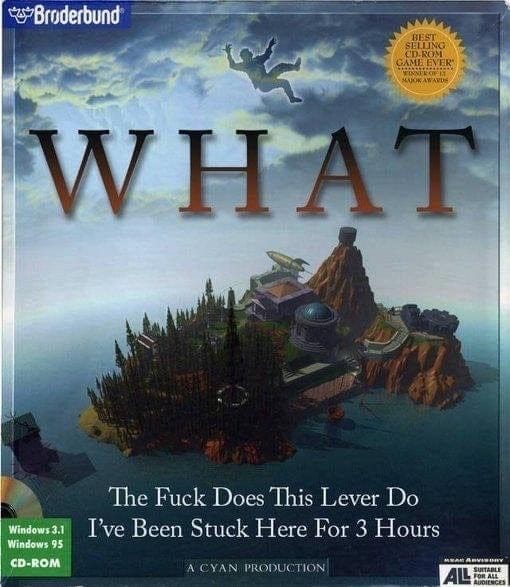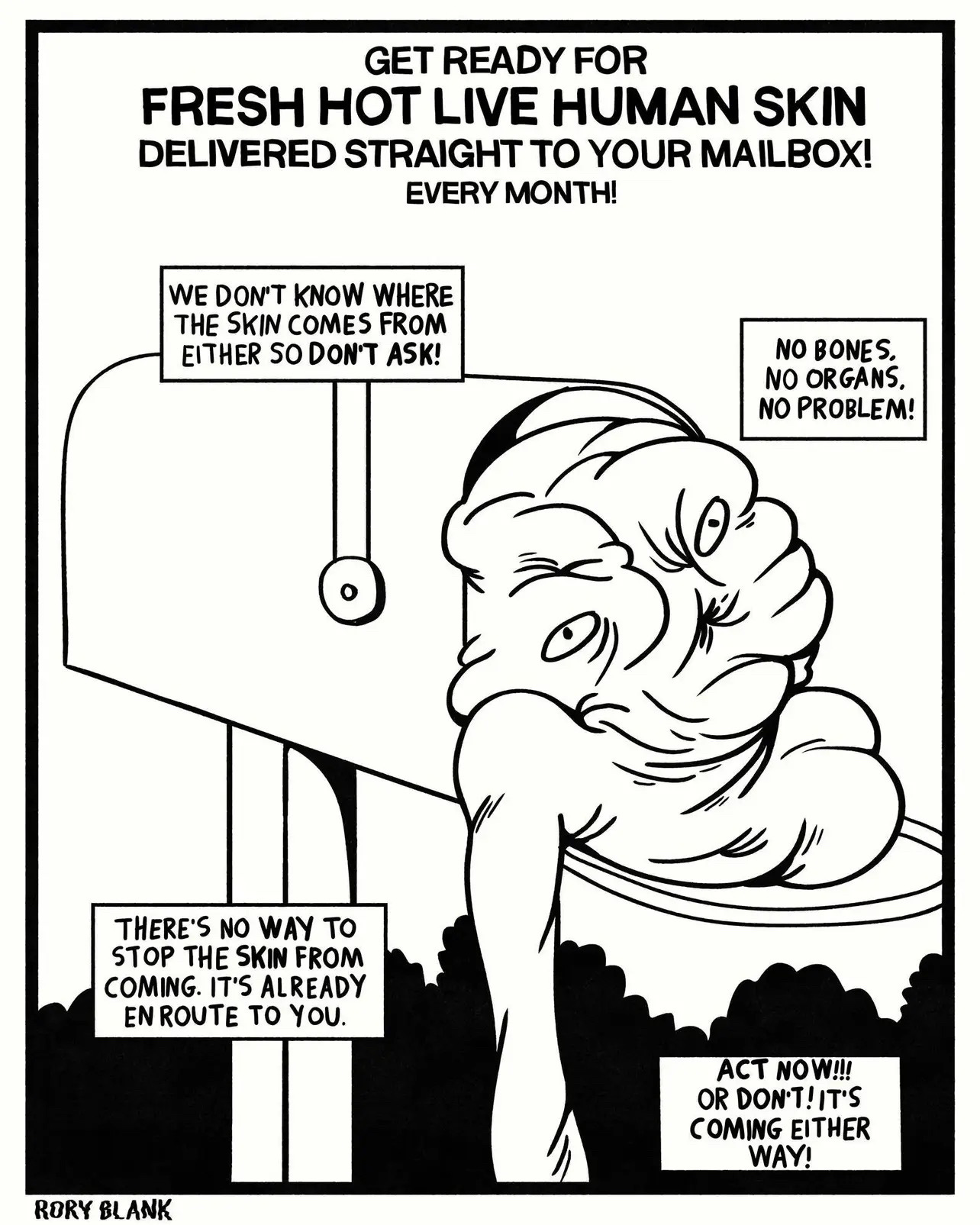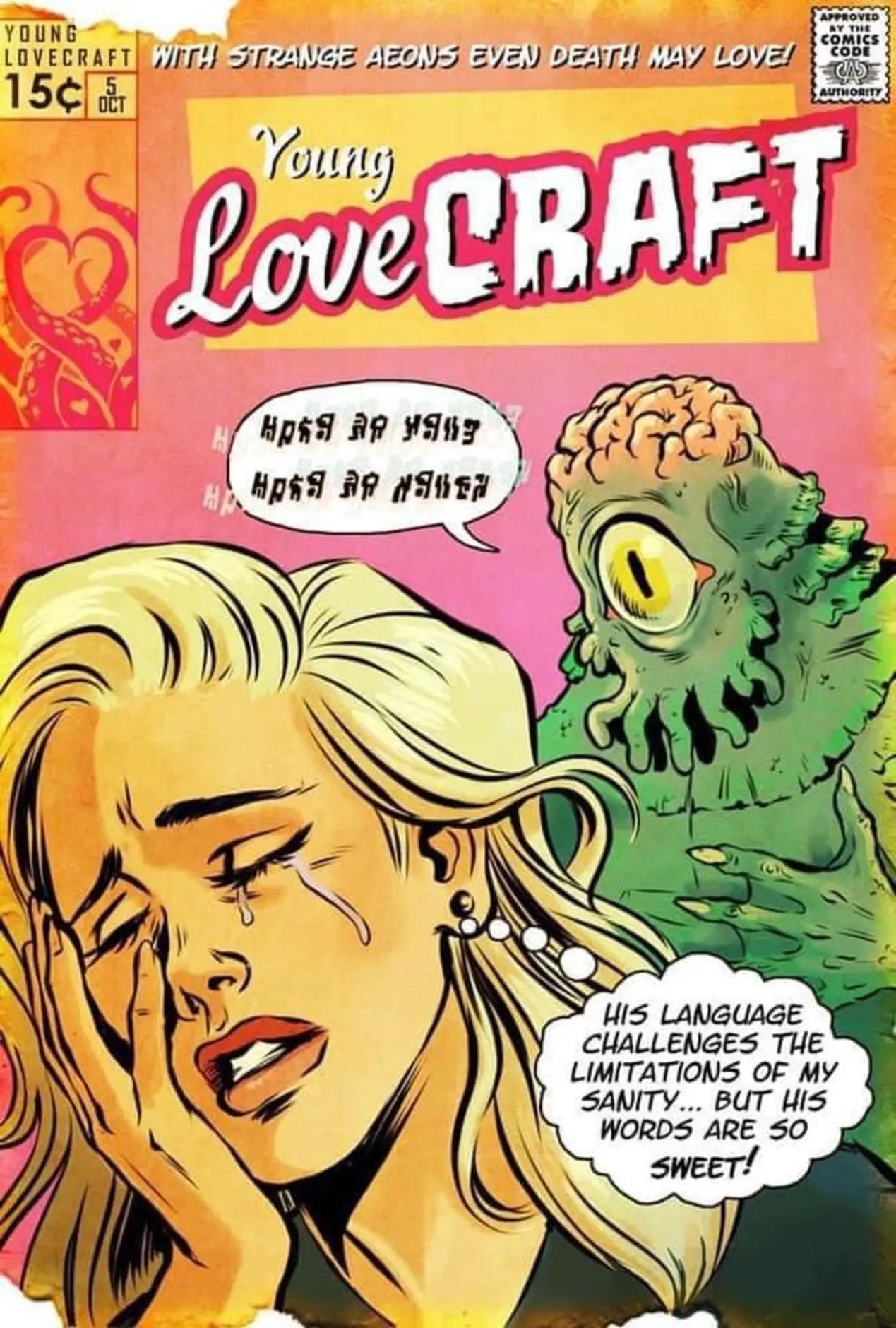Tonight’s Tarot:
The Sun – Linestrider Tarot Deck
Freaks of Hazard:
BassnJay got in a monthly paypal for for $10! Thank you!!
Subscribe for the SXXY-est junkmail for your inbox right here!
OUR REINDEER COMRADE
ANIMAL WARS
Certain wars in history were caused by, and named after, animals.
Reindeer during WWII
How a Battalion of Reindeer Helped Defeat the Nazis in WWII
Reindeer herders’ skills were “highly valued” during World War II…Among Russia’s forces, the reindeer and their herders served a number of jobs during World War II, including acting as couriers, towing disabled equipment, and “even conducted covert missions behind enemy lines,” according to the Anchorage Daily News.
While Russia may have used reindeer in greater numbers than other countries and for the specific purpose of logistics, they were not alone in their use of the wartime animals; Finnish soldiers fielded them as well, and even used them against Russian forces during the Winter War — a bloody border fight between the neighboring countries that began in 1939 and ended in 1940.
Their wartime service during World War II led to the number of reindeer falling “dramatically” between 1939 and 1945, according to the Arctic Institute of North America’s research. Around 220,000 reindeer were killed in order to provide food alone. “The combined effects of military operations, a labor shortage, an increased number of predators, and difficult weather and snow conditions led to losses of reindeer,” according to the Arctic Institute’s research.
NARYAN-MAR, RUSSIA - APRIL 25, 2019: A monument to the WWII reindeer squadrons' members in Naryan-Mar, the capital city of Russia's Nenets Autonomous Area. Sergei Malgavko/TASS (Photo by Sergei Malgavko\TASS via Getty Images)
The Importance of Reindeer During WWII and the Post-War Reconstruction
Reindeer herding has been an important livelihood in northern Finland alongside agriculture and forestry, both of which have challenged herding since as far back as the 1850s…
In the Soviet Union, herders were drafted to fight as soldiers in the war with Finland, and their reindeer were confiscated. After Germany attacked the Soviet Union on the Kola Peninsula in 1941 in order to take Murmansk, the Soviet army decided to establish troops that would use reindeer sledges. …herders served with their trained reindeer from early 1942 until 1944. The main task was to transport weapons and ammunition to the front, move soldiers to behind enemy lines and retrieve wounded soldiers. Already during the Winter War (1939 – 40), it had turned out that herders coped extremely well with the harsh northern conditions and that reindeer were far more useful on the Arctic front than either tanks or horses.
Patrol consisting of reindeer and soldiers wearing snow camouflage clothing in Jäniskoski, Petsamo, northeastern Finland during the Winter War in 1940.
The War of the Stray Dog (Greece - Bulgaria, 1925)
The War of the Stray Dog: A War Sparked by Ridiculous Reasons
The familiar spark that torched our today’s battle came on Oct. 18, 1925 CE. In the morning hours, a Greek Soldier was guarding a border post at Demir Kapou pass. Suddenly, he saw a stray dog running to the other side, and the Greek soldier took a few steps into the Bulgarian territory to retrieve this lost dog. As expected, the Bulgarian guard aimed and shot the Greek soldier dead. This eventually started the infamous War of the Stray Dog.
Bulgaria emphasized that the firing was a result of an apparent misunderstanding and communicated its regret. Additionally, the Bulgarian government proposed forming a commission of Bulgarian and Greek officers to investigate the incident. When the 47-year-old Theodoros Pangalos, the Greek’s lieutenant-general, learned of the killings, he saw it as just more proof of Bulgarian treachery. The Greek administration refused any mediation as long as Bulgarian troops stayed on Greek territory.
…the Greek administration issued an ultimatum to Bulgaria of two days to punish those who were responsible, offer an official apology, and a couple of million French francs as compensation for the victims’ families. The Battle between Bulgarian and Greek forces started after the former refused to pay 2 million French francs in 48 hours. The Greek army moved through the enemy defenses with almost zero trouble and drove deep into the heart of Bulgaria, pillaging, looting, and leaving a trail of burned towns everywhere.
At Bulgaria’s request, the League of Nations (comprising almost all the major European powers) soon intervened. The League ordered an immediate ceasefire. They asked the Greek troops to retreat from Bulgaria and Greece to pay around £45,000 as compensation to Bulgaria. Both nations accepted the decision.
War History Online: Wars Fought for Stupid Reasons
It all began with the Ottomans who ruled an empire that included many diverse religions, cultures, and ethnolinguistic groups. Among these were the Greeks and the Bulgarians. Greece gained its independence in 1832, while Bulgaria did the same in 1908. The Ottoman Empire was Islamic, while the Greeks and the Bulgarians were Christians who belonged to the Eastern Orthodox Church. Greece and Bulgaria had also been members of the Balkan League which had fought for their independence. And though they got it, they faced the threat of a still formidable Ottoman Empire. The two nations had every reason to pull together and get along, but it didn’t happen. After the Balkan League had carved up the European side of the Ottoman Empire among themselves, Albania was formed, leaving Macedonia and Western Thrace, which Bulgaria and Greece wanted.
Greek and Bulgarian flags superimposed over a dog jumping through a barren battlefield (not the infamous dog that sparked the skirmish).
A British cartoon showing Tweedle Dee and Tweedle Dum as Greece and Bulgaria at war, with the UN represented as the dove of peace intermediating between them.
The Pig War (U.S. - Canada, 1859)
Military History Now / Oversimplified
On June 15, 1859, Lyman Cutler had reached his breaking point. The American farmer who had recently settled on San Juan Island, a tiny strip of land between Vancouver Island and what is now Washington State, was livid with a neighbor who led his free-range pig wander onto Culter’s land. The wayward hog, which had a healthy appetite, was fond of digging up the farmer’s property in search of potatoes. In a fit of anger, the piqued homesteader finally dispatched the beast with a blast from his shotgun.
The pig’s owner, an Irishman named Charles Griffith, was a British subject and employee of the Hudson’s Bay Company, a massive trading firm with outposts across the Canadian wilderness. …For years, San Juan Island had been claimed by both Britain and the United States. The disagreement over who owned it had served as a minor irritant for both countries since the 1840s. Negotiations between the two powers to resolve the dispute had been dragging on for the past two years.
Accepting that he was out of line for shooting the roving swine, Cutler apologized to Griffith and offered $10 ($370 in today’s money) to replace the beast. The Irishman demanded $100 (the modern equivalent of $3,706) instead. Cutler refused, pointing out that the animal had been trespassing and, in light of the damage the pig had caused to the crops, his initial offer was more than generous. The disagreement polarized the small island community, with the Hudson’s Bay Company employees supporting Griffith and the 25 American families on San Juan lining up with Cutler. When local British authorities threatened to arrest the farmer, his neighbors rallied, eventually calling on the nearest U.S. military post for protection.
Recognizing that a U.S. citizen was danger, a brigadier general with the Oregon Department dispatched 66 soldiers to San Juan Island. The small detachment was under the command of a flamboyant and hot-tempered infantry captain from Virginia by the name of George Pickett. (Four years later, Pickett’s would help lead a disastrous 12,500-man Rebel infantry charge into the center of Union lines at Gettysburg.)
Alarmed by the sudden appearance of U.S. troops on an island claimed by Britain, regional authorities in Canada responded by moving three warships into the waters off San Juan Island. Pickett, already a minor hero from the Mexican War a decade earlier, was eager to use the growing standoff to advance his own notoriety. As the crisis mounted he famously threatened “another Bunker Hill” if the British attempted a landing.
President James Buchanan, who was busy trying to prevent the outbreak of war between the Northern and Southern states, viewed the confrontation as an unwanted distraction. By October, both the British and Americans in the region had agreed to stand down. Not a single shot was fired by either side; the only casualty was a British pig. Eventually, it was agreed that each nation could position 100 troops on San Juan until ownership of the island could be settled permanently. Spoiler alert, it’s all part of WA state now.
source: WikiComons
In the late 1840s, the Juan de Fuca Strait in Puget Sound was flanked by British-occupied Vancouver Island, and the American Washington Territory. In June 1846, the Treaty of Oregon was signed in Washington, D.C., setting the boundary on the 49th parallel, from the Rocky Mountains "to the middle of the channel which separates the continent from Vancouver's Island.” However, the language was too ambiguous because there were 3 distinct channels between the various islands in the area.
Reports of the island's good soil and bountiful resources by Northwest Boundary Survey naturalists quickly circulated among American settlers on the mainland. By spring 1859, 18 Americans had settled on claims staked on prime HBC sheep grazing lands. They expected the U.S. Government to recognize their validity, but the British considered the claims illegal and the claimants little more than "squatters" or trespassers. Tempers grew shorter by the day.
Spanish for St. John’s Island
The Emu War (Australia 1932)
WW1 Veteran military operation to cull emus, large flightless birds, an agricultural pest. The campaign lasted from November to December 1932. Three members of the Royal Australian Artillery were assigned to cull roughly 20,000 emus using machine guns. The assignment was made in response to petitions from local farmers complaining of emus destroying their crops. After two months, fewer than 1,000 emus were reported killed. The failure was the subject of national and international ridicule.
Emus have been common in Australia for thousands of years. Three subspecies are recognized, inhabiting northern, southeastern, and southwestern Australia; a fourth, now extinct, lived on Tasmania. Emus frequently migrate hundreds of kilometers over the course of a year in search of food and water.
In 1922 the Australian government changed emus’ status from that of a protected native species to “vermin” in response to their destruction of large amounts of vital crops, such as wheat. Emus frequently broke through farmers’ fences, creating holes that then allowed pests such as rabbits to do more damage. Furthermore, when emus ate crops, they trampled anything growing nearby, causing even more damage to plants.
In 1932 an unusually large migration, caused by drought, led to massive damage to wheat crops in Western Australia, particularly in the Campion district.
IMAGINE DAHMER WITH A LAB COAT
SUB-PROJECT 68
⭐ Turn a dream into a reality
Stepping Foot On Campus - A little light clip to help set the mood, let’s hear on some of the hopes and dreams that the esteemed McGill University could provide someone.
Think About It Holistically - Also give us more money.
Declassified: Mind Control at McGill
⭐ CIA's secret brainwashing experiment: Former patients sue U.S. government (1984) - The Fifth Estate
Perfecting Techniques - What was driving the CIA to explore techniques such as Dr. Cameron’s? Welcome to Ravenscrag. It should also be noted that the Rockefeller Foundation helped found the Allan Memorial Institute.
The Cocktail - Quite the laundry list of drugs! Better watch out for poisonous psychosis.
De-Patterning - Time to crank that dial UP son!
⭐ Brainwashed: The Secret CIA Experiments in Canada - The Fifth Estate
Enter Dr. Cameron - The CIA was gonna have some problems trying to publicly fund their studies into brainwashing techniques. Your best bet is to turn to the pros!
Timeout From Motherhood - These referrals, I’ll you what!
We Were All Terrified - Doesn’t sound like Dr. Cameron was very pleasant to be around. This clip also touches briefly on the payouts sent to the victims. There are people still fighting for records and settlements till this day.
⭐ MK-Ultra: The shocking Cold War experiments hidden by the CIA - BBC REEL
What Did They Know? - Sounds like Allan Memorial had a whole pipeline set up thru the use of referrals.
⭐ MK Ultra brainwashing program: Former patients fight for settlement (1985) - The Fifth Estate
Shattered Lives - We here more on some of the experiences, this dude is a professor at McGill who’s dad was subjected to this treatment.
Psychic Driving - There’s a lot of moving parts to Dr. Cameron’s techniques, mostly vast amounts of drugs and electro shock therapy.
World Wide Reputation - This dude even experimented on his employees! Take a listen for what famous trial Dr. Cameron was present at.
⭐ Inside the CIA's Terrifying 'Sleep Room'
A Better Person - My favorite CIA youtube channel details more on the experiments.
Cameron’s Philosophy - What is it that brings a man to this point. Oh, it’s a tale as old as time!
⭐ MK Ultra: CIA mind control program in Canada (1980) - The Fifth Estate
Witchdoctors - It wasn’t just the studies at McGill they were interested in. They being the CIA.
In The Stables - Here in this clip we’ll hear who Dr. Cameron was tasked to study during those infamous post WWII trials.
⭐ Compensation for CIA-funded brainwashing experiments paid out to victim's daughter 60 years later
Hush Hush Money - The government’s f i n a l l y after 60 years had to cough up some extra dough, but is 100k really worth all that much?
⭐ Allegations of unmarked graves at Montreal’s McGill University
Stop The Construction - Mohawk mothers attempt to put a halt to upcoming construction at McGill as they believed, wait for it, that there are unmarked graves on the campus.
Victims From The 50’s - They want the files that McGill has dammit! Also, what’s up with the residential schools Canada?
According To The Studies - It’s unlikely anyone would find anything. It always feels like these institutions are rubbing it in the faces of people when they claim this land belongs to X.
🌙 Mohawk Mothers reach agreement to search for unmarked graves
The agreement establishes how archeological mapping and digs will proceed on the surrounding site of the old Royal Victoria Hospital, which neighbours the AMI, and eventually allow McGill’s New Vic project to go forward.
A panel of expert archeologists selected by all parties will determine how digs will proceed, and Kanien’keha:ka cultural monitors will also be present on site during archeological works, and the agreement also compels the McGill University Health Centre and the federal government to expedite the release of records relating to the Allan Memorial experiments.
⭐ McGill pressured to address colonial history
The McGill Experience - But no mention of mentally shattering people…
⭐ Road to 200: Dr. Alan Evans - Can big data help explain how our brains work?
So Called Big Brained - Given what we know now, this clip just rings creepy. Also, give us more money.
🌙 Declassified: Mind Control at McGill
OPENER
Doug Stanhope - Excess in Moderation
INTERMISSION
Sailing to Antarctica - White Triangles
Putting no ability points into charisma
Queen Of The Midday World - Daves Not Here
CLOSER
PRESHOW
OC Rippers - Late Night TV Lover
Namo Maitri - About That (Have My Money)
The Doerfels - Worth Fighting For
Ariel Powell - Do What You Will
Jimmie Bratcher - Happy (Instrumental)










